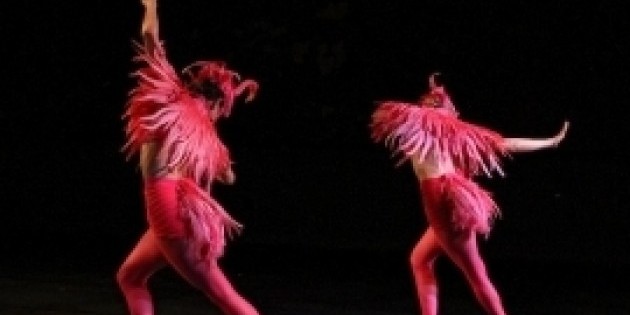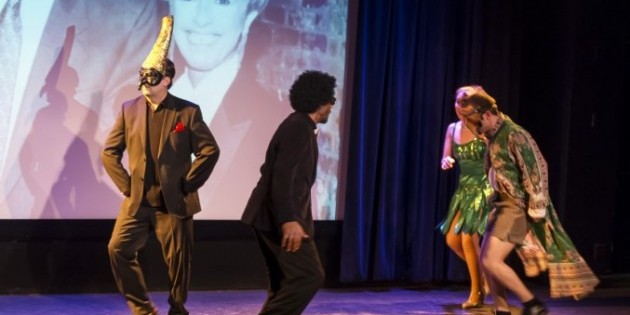The Dance Enthusiast Asks Joanna Kotze

Collaborative Meldings of Time and Space
The Work of Choreographer Joanna Kotze
A Premiere at St. Marks in the Bowery
Veronica Hackethal, for The Dance Enthusiast
Joanna Kotze will premiere her new evening length piece, It happened It had happened It is happening It will happen, from May 30-June 1, 2013, at 8PM at Danspace Project, St. Mark’s Church in-the-Bowery. The performance highlights a trio of dancers: Stuart Singer, Netta Yerushalmy, and Kotze.Also featured will be music composed by Dave Ruder, costumes designed by Reid Bartelme, and lighting designed by Kathy Kaufmann.
Kotze, originally from South Africa, began formal ballet training at age six at Indiana University. While studying architecture at Miami University in Ohio, she danced in a student modern dance company. After moving to New York City in 1998 to pursue dance, she has performed throughout the United States, Canada, Europe and Mexico. Kotze, on the faculty at Movement Research, currently dances for Kimberly Bartosik/daela and Netta Yerushalmy.Her choreography has been presented throughout New York City.
Recently Kotze spoke with The Dance Enthusiast about her upcoming performance, her sources of inspiration, and her creative process.
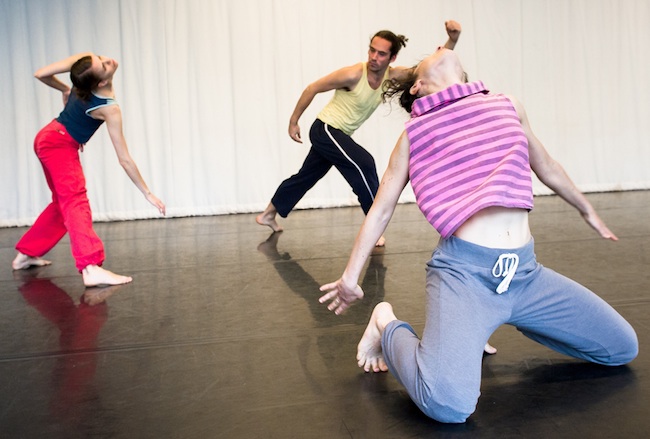 |
| Joanna Kotze's It happened It had happened It is happening It will happen; (pictured) Joanna Kotze, Stuart Singer, Netta Yerushalmy; Photo Ian Douglas |
Veronica Hackethal, for The Dance Enthusiast:Tell us about your upcoming performance.
Joanna Kotze: It began as a studio series about a year ago, but the seed has stayed the same.We were working with the play between reality and imagination, the known and unknown, the public, the private, the clear, the unnamable.The piece confronts the seductiveness of classifying, ordering and structuring, while attempting to hold onto the character of the unnamable, vulnerable and imaginable.
How we engage the audience is important to me, so that the performance is not an external experience for them, but it’s something they’re involved in. I think it brings in a "tenselessness".The audience comes in with their past and their perceptions.This performance is happening in the present.They’re going to leave and hopefully have some kind of future with it.
TDE: You seem interested in the boundaries of time—past, present, and future existing together.Could you explain this in the context of your new piece?
JK:In this new piece, the dancers will introduce the space and themselves to the viewers in ways that make time feel at once past, present and future. I was reading a book by Georges Perec called ‘Species of Spaces in Time.’ While reading it, I realized that what we were experiencing didn’t have a tense-- that past, present, and future exist simultaneously.
Kotze has received numerous grants and fellowships from organizations such as Gibney Dance Center, Ailey’s New Directions Choreography Lab, and the Foundation for Contemporary Arts.Most recently she was awarded a 2013 Bogliasco Foundation Fellowship at the Liguria Study Center for the Arts and Humanities in Italy.She spoke with TDE about her experiences at this residency.
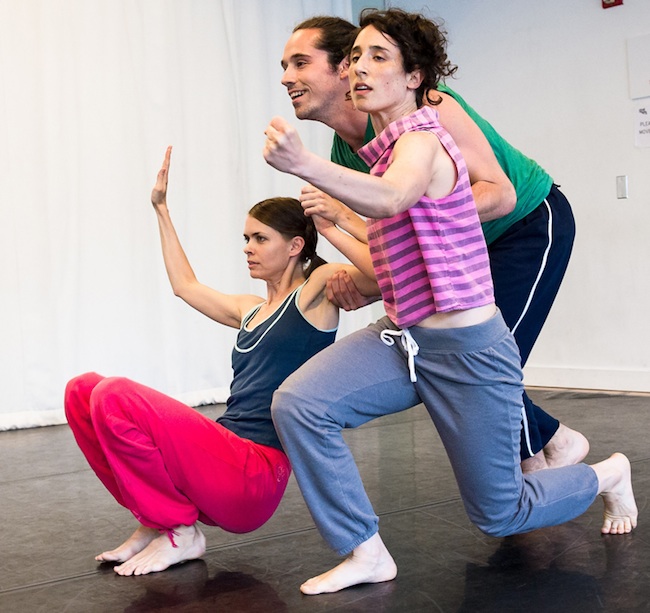 |
| Joanna Kotze's It happened It had happened It is happening It will happen; (pictured) Joanna Kotze, Stuart Singer, Netta Yerushalmy; Photo Ian Douglas |
TDE: How has your recent fellowship in Italy affected your work and creative process?
JK: It’s a very unique place and it was a challenge for me to work for five weeks completely on my own.It definitely took me out of my comfort zone.Other bodies are comfort for me.The time to think, read and write was just as important as physically moving.Here in New York I feel the pressure of time, like I need to use every minute in the studio because I’m paying for every hour.When you have all that time to yourself in a residency, it’s not a reality that you will be able to move all day.So you do other things that you normally don’t have time for.I realized just how much we need that time as creators.
TDE:How has the residency affected this new piece, or even pieces beyond it?
JK: Having that time on my own has infiltrated everything that I’m doing.For this current piece we were working a lot with open practices, improvisation, and learning things from video.When I was by myself, I went back to my body and created movement one piece at a time.I’ve done a lot of that in the past.It feels right to come back to it, from a different angle.”
TDE:How do ideas of time, space, the built environment, and physical space play a role in your work?
JK: Architecture, dance, and choreography are very intertwined for me.Architecture is the design of space and bodies in space, and choreography is the design of space and bodies in space.The movement that was happening in the dance studio influenced what I would design in the architecture studio, and vice versa.I became interested in questions like how to use space, how to see space, how I would want to move through space, how I would want other people to move through space, how I would want other people to view space.I wasn’t the student that made square boxes in architecture school.There was usually a sense of movement and space.
If I know where something is going to be performed, I really account for how it can be performed uniquely in that space. For past pieces I have introduced architectural elements, movable built lights, and other design elements.With this upcoming piece, I kept wanting to put something in the space. I thought, “There has to be something else there, people need something to look at.”But it never made sense for this piece. I had to let that go and realize that the piece was telling us it didn’t need it.
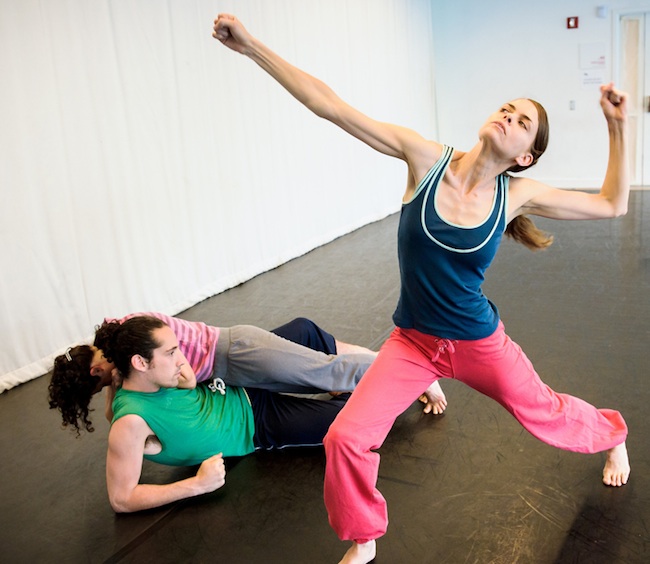 |
| Joanna Kotze's It happened It had happened It is happening It will happen; (pictured) Joanna Kotze, Stuart Singer, Netta Yerushalmy; Photo Ian Douglas |
TDE: In your past work you’ve engaged in a lot of cross-collaboration with different art forms.Will this continue to influence you?
JK: Collaborators are very important to me, and I have a lot of trust in them. Their presence, their skill, their bodies, their minds, are definitely a source of inspiration for me.I am very highly influenced by my husband, Jonathan Allen, who’s a visual artist.I’ve also collaborated with another great visual artist Asuka Goto. I’m very interested in collaborations, whether it’s with other dancers, dance makers, visual artists, sound creators, lighting designers, or costume designers.I’m excited to expand those relationships further.











